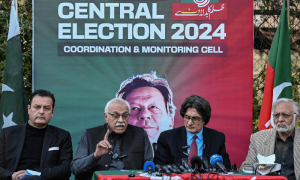WHAT was the drone doing inside Pakistani airspace? The confirmation by the Foreign Office on Wednesday that the Pakistan Air Force had shot down an Iranian drone over Panjgur, Balochistan and the silence thus far by Iranian officials suggest that the drone did not accidentally slip into Pakistani airspace. The location also hints at increased Iranian surveillance of a region in which CPEC projects are in full swing. The latest incident along an already tense Pak-Iran border ought to serve as a warning to both states: address through dialogue the apprehensions of the other or risk an unnecessary and undesirable escalation in tensions that neither country can afford at this juncture.
From a Pakistani perspective, suspicions of Iranian motives are not unreasonable. Iran has positioned Chabahar as a rival to Gwadar, and India has hyped the seaport as the answer to landlocked Afghanistan’s search for a reliable, uninterrupted trade route. With India’s hostility to CPEC well known, and Iran perhaps worried about a greater Chinese presence in Balochistan, it is possible that Iran and India are working together along the Pak-Iran border to spy on Pak-China activities in the region. Yet, Pakistan has consistently maintained that it seeks stable ties with Iran, so it should be possible for the latter to raise diplomatically with Pakistan whatever concerns it has. If the concerns are reasonable, a framework can surely be prepared to address present-day and future bilateral complaints. From an Iranian perspective, the act of its drone being shot down by Pakistan could be seen through the prism of the current turmoil in the Middle East. Hawkish elements in Iran may interpret the shooting down as a signal from Pakistan to Saudi Arabia that Pakistan is taking steps to, at the very least, distance itself from Iran or perhaps even engage in low-level conflict with it.
While that characterisation would be wrong — Pakistan has made clear that it does not intend to be drawn into a conflict between Saudi Arabia and Iran — it does underline the risks of a tense Pak-Iran border in the absence of a robust bilateral dialogue. Before this drone incident, there were already increased terrorism- and crime-related concerns on both sides of the border. Instead of adding to bilateral problems, the Iranian and Pakistani leaderships should remember that the two countries have had stable ties for much of their history. That history of stability and warmth was made possible by putting bilateral friendship at the heart of the relationship and not allowing third-party interference. The border region between Iran, Afghanistan and Pakistan must be carefully managed given competing regional and global interests. But the Iran-Pakistan relationship must not be reduced to simply a zone of anxiety and concern that has to be constantly managed. Dialogue is the only sensible way forward.
Published in Dawn, June 23rd, 2017











































